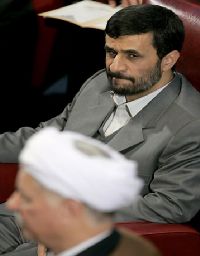October 14, 2007
Iran: The Looming Showdown

By Ali Nourizadeh
London, Asharq Al-Awsat- Among the most renowned kings of the Qajar dynasty that ruled Persia for over 150 years was Nasser al Din Shah who was known to be illustrious and highly cultured. Upon visiting Queen Victoria in Windsor Palace during his first trip to the United Kingdom in the mid-nineteenth century, he drew a picture of her and inscribed a poem in French under the drawing that said: “the heart cannot love two at the same time… It is an ugly thing like a body with two heads.” *

This encounter inspired the royal court minister of information, Mohammed Hassan Itimad al Sultana to write a fictitious account of the visit to Windsor palace. He adapted the encounter to be a melodramatic love story in which the Shah of Iran was the protagonist and the Queen of England his beloved. At the end of the story, the fictitious character of Nasser al Din poisons the Queen’s tea and she dies in his arms. Itimad al Sultana professed that the moral of his story illustrates that the world is not big enough for two royals, while 40 Sufi dervishes could repose on one bed.
To a large extent, the present situation in Iran bears a resemblance to Itimad al Sultana’s story except this time it’s not fictitious. This time, the two heroes are two men who have been loyal to one another since over half a century ago, sharing both joy and grief they have even been imprisoned and exiled together. The passage of time saw their transformation from preachers and reciters of religious songs into two formidable politicians governing over Iran.
The first is Ali Akbar Hashemi Rafsanjani who was a student under the leader of the Islamic revolution Ayatollah Khomeini, and the second is Ali Khamenei Narrowly escaping death, Khamenei was almost martyred for the cause of the revolution after an explosive device was found planted by his comrades into the microphone he was using to deliver a speech.
Following that incident, fate decreed that Khamenei serve as president of Iran, while his compatriot Rafsanjani, who was the parliamentary speaker at the time, was dispatched by Khomeini to assume his duty of leading the battle front of the war against Saddam Hussein. The former Iraqi president had hosted Ayatollah Khomeini for 15 years, however upon the latter’s return to his country, Saddam proclaimed him a heretic and tyrant.
On his deathbed, Ayatollah Ruhollah Khomeini summoned his students and warned them against dissension. He said: I have conquered an emperor who had the support of the world on his side, and I was able to accomplish that because the people were on my side. But this support will not last if the people sense that there are divisions or conflicts among you. I warn you against hypocrisy and your comrades; you must back one another. If someone came to you, my son Ali [Khamenei], and said that Ali Akbar [Rafsanjani] is criticizing you and conspiring against you, or [addressing the rest of the students] if Ali Akbar [Rafsanjani] who is the closest person to you came to you and started whispering words against Ali [Khamenei] you must dismiss them and take no heed of their words.
Khomeini died the following day and the two partners headed to the Assembly of Experts to appoint a successor to their deceased mentor. But there were 80 faqihs [Islamic jurists] who were among the highest clerical echelons and who far surpassed Ali Khamenei and Ali Akbar Hashemi Rafsanjani in rank. What the assembly witnessed during this historical meeting is still etched in the minds of many Iranians who were surprised to hear Ali Akbar addressing the members of the assembly saying: I asked our late Imam in the last hours of his life who he thought was qualified to assume the responsibility of leader and Wali Faqih [Guardian Jurist] after him. He responded immediately in a calm and confident tone and said: As long as it is between you, Ali, my son… Do not consider anyone else.
Thus, having spoken these few words, Sheikh Ali Akbar Bahramani, who is known as Hashemi Rafsanjani, nominated his life-long associate Ali Khamenei for the post of Guardian Jurist, while he assumed the presidency. Upon exiting the Assembly of Experts’ meeting, they became the most powerful figures in Iran.
Moreover, theirs was a partnership that had weathered many storms whilst remaining solid and intact. Together, they braved an avalanche of reforms while surpassing obstacles and conflicts as they appeared. However, Khamenei, after years of sitting atop the Supreme Guide’s seat, started to feel that he no longer needed a partner. He now had the ability to appoint and dismiss, and grant power or seize it as he pleased. Effortlessly, with a snap of his fingertips, Khamenei could bring someone to world renown very quickly. So, why was he sharing the power when the authority was tightly clasped in his hands?
Thus, Khamenei forgot the words and warnings of his mentor and during the last presidential elections he abandoned Ali Akbar to support the incumbent president, Mahmoud Ahmadinejad, who was little known at the time. Rafsanjani could not believe that Khamenei had stood by someone else, which is why upon ascertaining the news he did not utter a word of complaint except to God.
Since the presidential elections [August 2005] until last Tuesday 4 September, Rafsanjani had lived with his sorrow. Whenever his son would show him articles and websites in which Khamenei and Ahmadinejad were harshly criticizing him on a daily basis, he would smile and say: Son, the story is not over yet. Just wait a little bit and you’ll see that the day will come in which my partner will feel remorse for what he did to me.
Last Monday morning, Rafsanjani walked into the Assembly of Experts’ building. It was the result of the clever game he played 18 years ago following the death of his mentor Khomeini that enabled his friend Khamenei to ascend to power.
The newly appointed head of the Assembly of Experts sat behind the podium with his customary calm demeanor and delivered an important speech in which he discussed the state’s nuclear program issue and relations with the US. As the speaker of the powerful clerical body, Rafsanjani heads the Assembly of Experts which has the power to dismiss the Islamic state’s highest authority, the Supreme Guide, Ali Khamenei.
Rasfanjani received 41 votes, while his opponent, hardliner Ayatollah Ahmad Jannati, who was backed by the Supreme Guide and the President, received 34 votes of which one was cancelled on the grounds of invalidity.
Thus, Sheikh Ali Akbar emerged victorious, and once again, the authority and the presidency have two heads that disagree with one another.
In the aftermath of the presidential elections, as a result of the concern and fear prevalent amongst the reformists and the pragmatists, Rafsanjani, [Mohammad] Khatami and [Mehdi] Karroubi formed an alliance to consolidate the reformists’ power, among them students, women, academics and the cadres who were appointed in the reformist leadership. This move is a preparatory one for the upcoming parliamentary elections next March.
But Ahmadinejad who enjoys the limitless support of the Supreme Guide and the radical circles in the judiciary, intelligence and the Iranian Revolutionary Guard Corps (IRGC) did not take these developments sitting down. He closed down two pro-reformist newspapers, the daily ‘Shargh’ (East) and Ham Mihan (Compatriot), which were widely read and circulated, in addition to banning the moderate labor news agency ILNA.
These moves were aimed at depriving the pragmatists and reformists of their communication media vehicles and platforms. Internet sites, which constitute an important medium for these aforementioned trends have also been targeted, many of them restricted or shut down while all of them are being closely monitored. These developments coincided with the launch of carefully calculated smear campaigns against reformists and pragmatists in newspapers, on the internet and in mosques some were even included the religious sermons delivered in mosques. Scores of university professors have been removed from their positions, including Dr. Hossein Bashiriyeh, Dr. Saeed Shahandeh, Dr. Mohsin Kadivar, Dr. Hadi Semat, while students were subjected to raids and arrests.
It is worth noting that with the efforts to tighten the iron grip on the reformists and those who hold different opinions, some of the key reformist figures have started to distance themselves away from their allies, Mehdi Karroubi is an example. Word among the reformist circles is that the authority has succeeded in gaining the loyalty of distinguished reformists, such as Karroubi, after promising them parliamentary seats in return for disassociating from Khatami and Rafsanjani.
Observers uphold that Iran is living turbulent times where differences are clearly pronounced, but moreover, this comes amidst increasing talk about the possibility of a US attack on the nuclear and military installations. Meanwhile, others anticipate demonstrations in the wake of the government’s implementation of the oil quota system, which is responsible for the plunge in the country’s economy and the reason behind the escalation of the dispute between Ahmadinejad and the former governor of Iran's Central Bank, Ibrahim Shibani. The conflict snowballed to affect government ministers and intrude on the lives of millions of Iranians. According to official figures, the inflation rate in Iran has exceeded 14.5 percent, while independent sources at the Central Bank maintain that it is 22 percent. Iran’s stock exchange has also witnessed a significant drop in the value of shares whilst unemployment has reached 20 percent.
Despite all that, some regard the situation more positively while others uphold that the economy is not as bad as the opposition claims.
However, between the existing discrepancies in Iran many stories are told.
* During his visit to the United Kingdom in 1873, Nasser al Din Shah was appointed by Queen Victoria a Knight of the Order of the Garter, which is the highest English order of chivalry.

